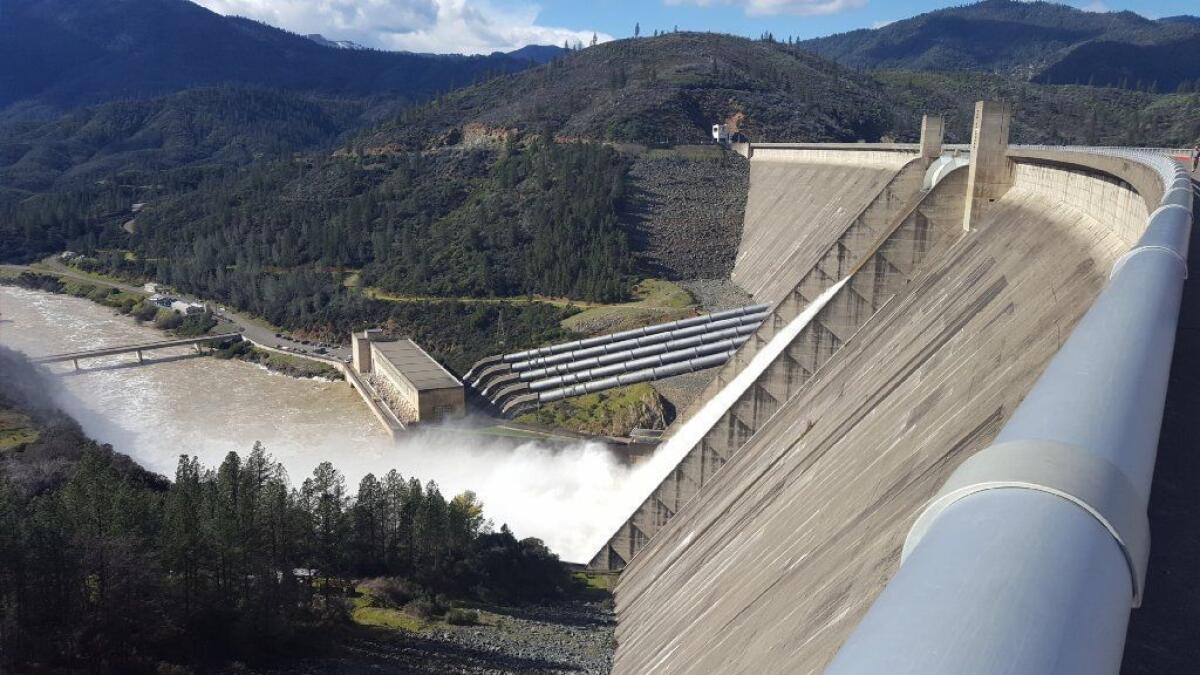
We could be headed into another drought. There’s little Sierra snow and valleys are dry. Is California ready this time?
Not really.
Good signs: There’s still a lot of water stashed in reservoirs from last year’s abnormally wet winter. And we’ve become better at using less water in our homes and yards.
One very bad sign: We haven’t increased our water storage capacity.
Government at all levels moves at a glacial pace, especially when it’s trying to deal with the complex and contentious issue of water.
Four years ago in the midst of a scary, five-year drought — one of the state’s driest periods in recorded history — voters eagerly approved a $7.5-billion water bond proposal, Proposition 1. The vote was a lopsided 67% to 33%.
A key selling point was $2.7 billion set aside for additional water storage. Most voters probably envisioned new dams, although projects to replenish groundwater basins also were eligible for the money.
The remaining $4.8 billion was earmarked for myriad things: regional projects, recycling, desalination, watershed restoration, environmental protection, groundwater cleanup, wastewater treatment, flood control. Roughly 86% of that money has been appropriated by the Legislature, although only 14% has been spent.
In writing the ballot measure, legislators handed the $2.7-billion storage pot to the California Water Commission to safeguard it from legislative politics. How much of the money has the commission allocated? Zilch. In fact, no projects have even been approved.
Tempers flared in the water world recently when 11 proposals scored badly in the first round of competition for the bond bucks.
“It’s causing lots of people to scratch their heads,” says Tim Quinn, executive director of the Assn. of California Water Agencies.
Water is wonky and the laws are convoluted.
Basically, water projects for agriculture and domestic use are funded by consumers. That means irrigation and water districts finance the projects and bill the ratepayers.
But under Proposition 1, the state general fund — paid into by all taxpayers — will kick in for bonds to fund a project’s “public benefits.” These benefits include such things as recreation, flood control and environmental protection. The $2.7 billion can only be spent on public benefits and cannot exceed 50% of a project’s cost.
There seems no danger, however, of state money coming anywhere close to paying for half of most projects.
“We’ve got applications asking for a total of $5.8 billion and we have $2.7 billion,” commission Chairman Armando Quintero says. “This is a competitive process.”
Just what the competition rules are, however, is baffling local water officials. So Quintero and his staff have been meeting with project honchos to help them tweak their money requests. A final decision on what each project will get is slated for July.
So far, the commission staff has found little or no public benefit to most of the projects.
Scoring highest were two “conjunctive use” projects that would bank reservoir water underground for use in dry years. One is in Sacramento County. The other is in the Chino Basin water district in San Bernardino County.
But the commission staff wasn’t very enthusiastic about two big dam projects.
One is Sites, 14 miles west of the Sacramento River near Colusa. It leads virtually everyone’s A-list for new reservoir proposals. It could hold 1.8 million acre-feet of water and become California’s seventh largest reservoir. Total cost: $5.2 billion. Local leaders asked the state for nearly $1.7 billion. The commission staff found the project eligible for only $662 million.
“It’s disappointing,” says Jim Watson, general manager of the Sites project, which involves 33 water agencies and local governments. “This reservoir is long overdue and needed.”
Coverage of California politics »
But Sites fared much better than the proposed $3-billion Temperance Flat dam on the San Joaquin River near Fresno. Its storage capacity would be nearly 1.3 million acre-feet. Backers asked for $1 billion. The staff judged it eligible for zero.
“Four years later [after the bond vote] and no storage money has been spent,” complains state Sen. Jim Nielsen (R-Gerber). Sites would be built in his district. “That’s the disgusting and frustrating way government works.”
There’s a suspicion among many Republicans and dam advocates that the Democratic-controlled state government, influenced by environmentalists, is looking for any excuse not to build more reservoirs.
“That’s the furthest from the truth,” says Chris Orrock, spokesman for the Water Commission. “We just want to make sure the benefits are real and they’re realized. This is an investment program, not a grant program.”
Quintero, the commission chairman, says: “Every single commissioner is interested in seeing that all the money goes out for water storage.”
Most people would probably say that California needs several more dams. But, in fact, there are more than 1,400 dams in the state. At least 1,000 are major, and 55 can hold more than 100,000 acre-feet of water. The largest 200 have a combined capacity of 41 million acre-feet.
There’s at least one dam on every river running off the west slope of the Sierra, except the Cosumnes, which doesn’t have enough water to bother.
Dam builders need to be leery of earthquake faults. They’re all over California.
Refilled aquifers, recycled water and desalination are the future — not several more humongous, expensive dams.
But there’s no reason to keep sitting on $2.7 billion the voters want spent on new water storage.
Follow @LATimesSkelton on Twitter
ALSO
Latino voters could make all the difference in California’s narrowing race for governor